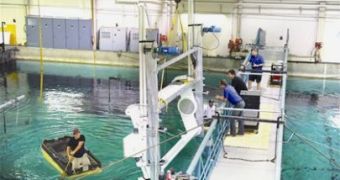The researchers at the U.S. Air Force Academy have tested their ocean wave energy converter on the largest scale to date. This means the converter's technology readiness level, or TRL, can now be increased from Level 3 to Level 4.
A TRL Level 4 means that a component of a system has been validated in a field environment. The last step, Level 9, designates a mission-ready product that is prepared for full-size, large-scale use.
The project started back in 2008 as a way to create the world's first free-floating, fully submerged wave energy converter that generates electrical power from deep ocean waves.
At first, the team behind the project built parts of the current wave energy converter in a garage and then tested components in a swimming pool. But with the change to larger scale, difficulties increased exponentially.
They are scheduled to return to the Offshore Technology Research Center in early 2012 to test the use of multiple wave energy converters working at once in different depths.
The center reportedly has one of the world's largest wave tank facilities, which will allow the test of a larger wave energy converter, and even of three wave energy converters simultaneously at a later time.
"We are now at the 1:10 scale, which is the scale that off-shore industry consider when they test their devices, and really the last step before building a full-size ocean-going device," said Dr. Stefan Siegel, a researcher at the Academy's Aeronautics Department. "The main goal is really to demonstrate how much power we can extract with wave energy and convert it to shaft power."
Another thing worth mentioning is that the research team managed to harness no less than 99 percent of the power of a simulated ocean wave with their ocean wave converter and transfer that wave's force into electrical energy, effectively canceling out the wave in the process. “Essentially, there's a wave going in, but no wave going out,” Siegel explains.
Taking into account the fact that the nearest comparable power source, wind turbines, can only harness 59 percent of the power potential within its area of effect, this is a huge step forward.

 14 DAY TRIAL //
14 DAY TRIAL //